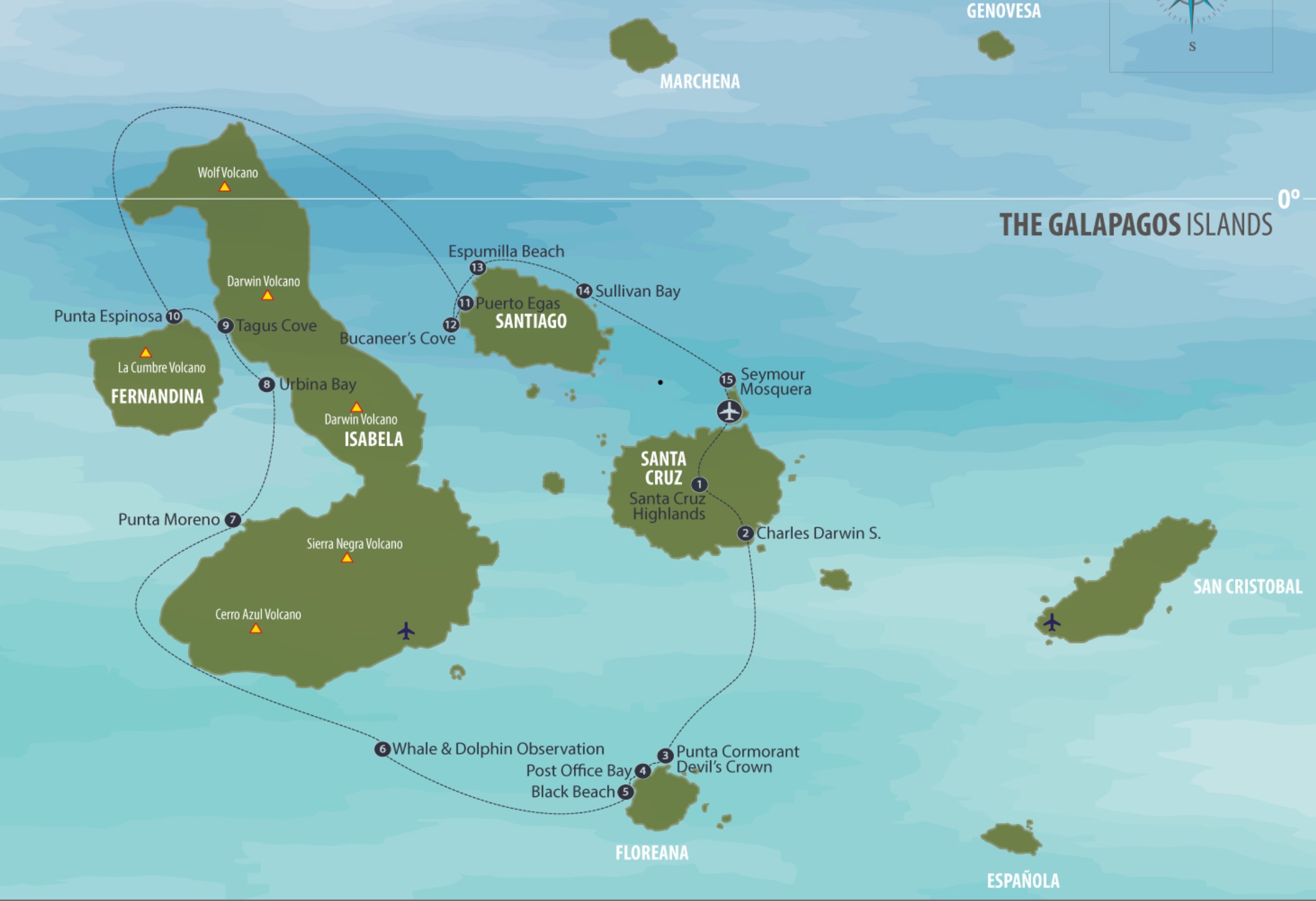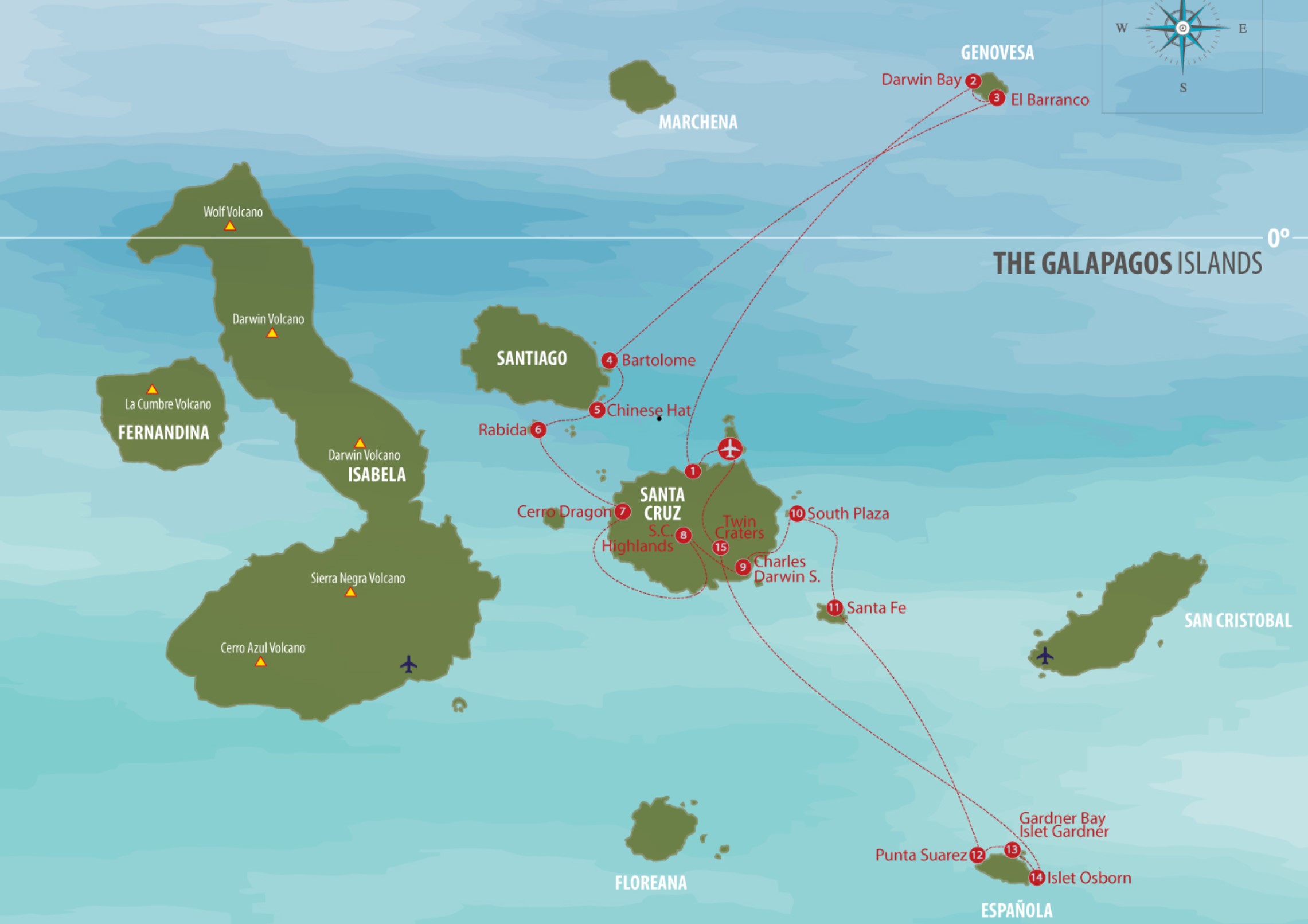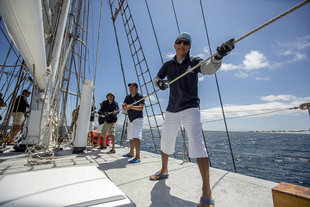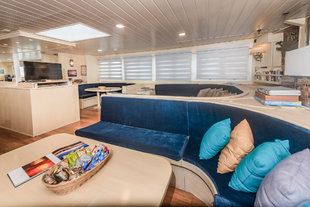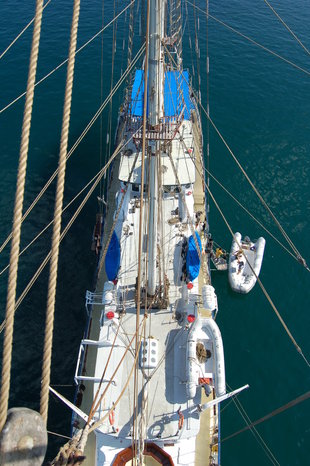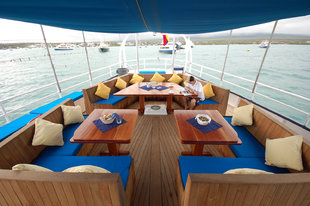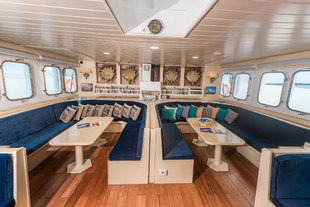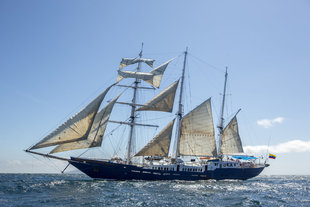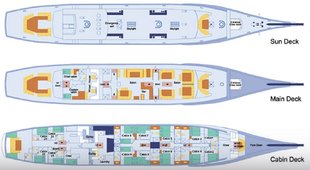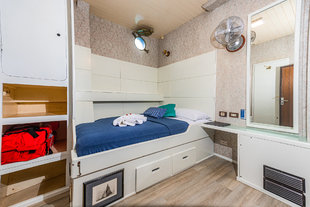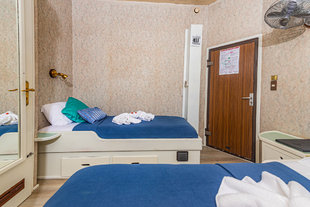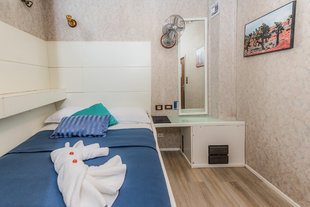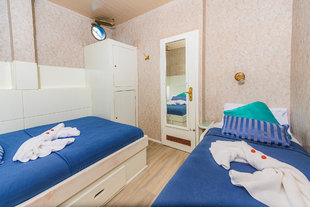Mary Anne is probably the most attractive 'tall ship' in the Galapagos and a wonderful subject to add to your photographs of the islands. Specially designed to offer a truly exhilarating sailing experience, the Mary Anne is one of the few ships in the Galapagos onboard which you will have the opportunity to participate in the hoisting of sails. She has three open decks with plenty of seating from which to observe the islands and search for wildlife. She has ample space above and below decks to find your own space, with all interiors decorated to a high standard.
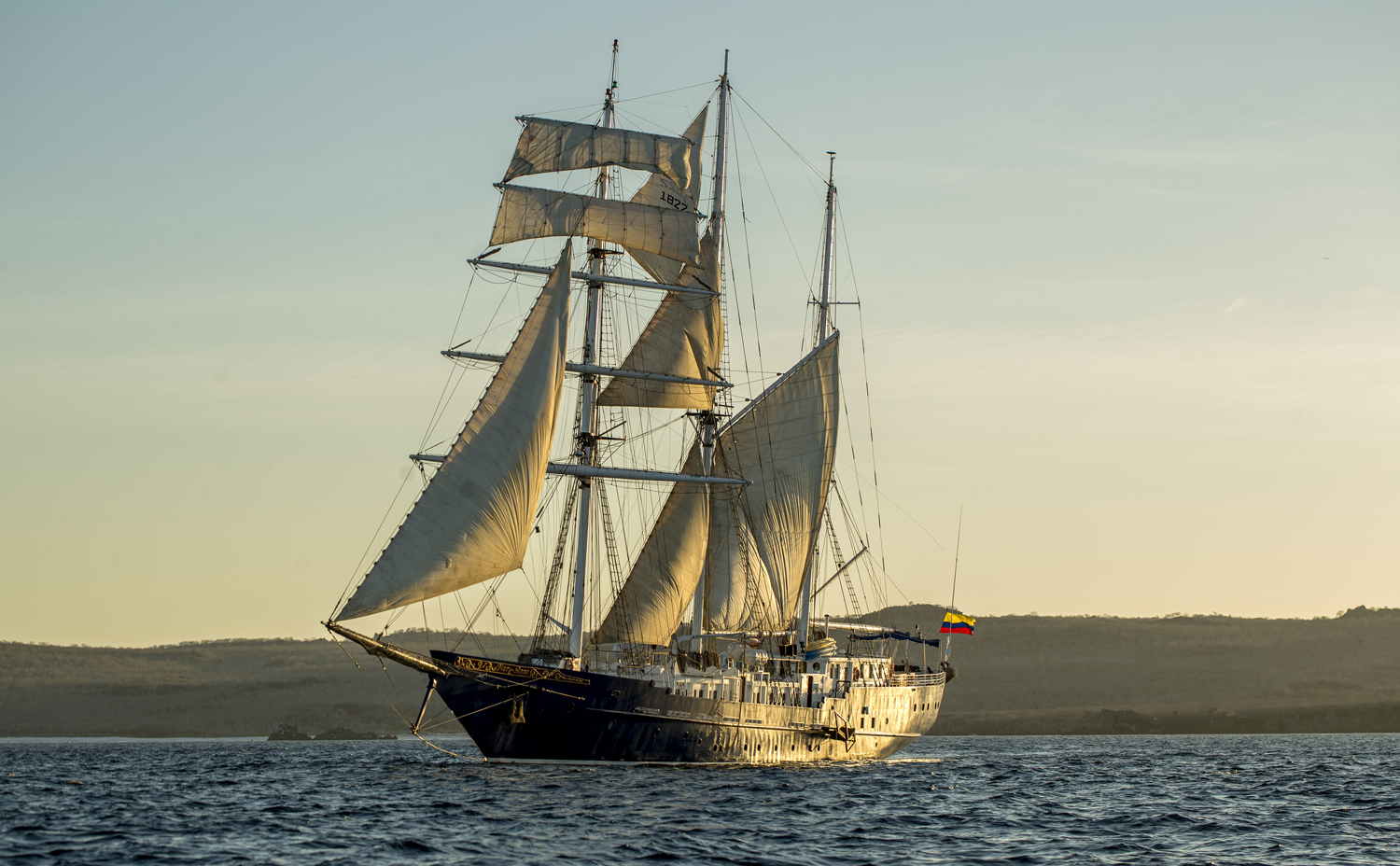
She has 10 well-fitted air conditioned cabins with private en-suite facilities, with the unique option of staying in a single occupancy cabin, but without having to pay an additional surcharge. Guests can unwind in the elegant wood-paneled salon or make use of the onboard library. There are dining facilities both above and below deck, with an additional bar area for guests to relax with a drink.
Whilst the yacht may be large, this by no means interferes with your opportunities to be in intimate contact with wildlife, land and water. There are plenty of opportunities each day to join guided exploration on land and snorkel to see the island's spectacular marine life.
Mary Anne offers guests the opportunity to assist with the sails when they are used, which is an exciting experience for both beginner and expert sailors.
Technical Specifications
|
|
|
|
|
|
|
|
|
|
|
|
|
|
|
|
|
|
|
|
|
|
|
|
|
|
|
|
|
|
|
|
|
|
|
|
Itinerary
Please note that these itineraries are subject to change without notice due to seasonal changes, last minute weather conditions and the decision of the Galapagos National Park authority.
Day 1: Morning Flight to Baltra then Highlands & Fausto Llerena Tortoise Breeding Centre
After arriving at Baltra airport, we will be greeted by an Angermeyer Cruises representative and then board a bus that will take us to the Highlands of Santa Cruz Island for our first visit in the Galapagos. The Highlands are lush and green in contrast to the arid coastal vegetation. The highland forests are dominated by the endemic Scalesia tree and are home to many bird species, including the shortear owl. Here, we will have lunch at a local ranch while looking for the famous giant tortoises, which are in constant migration from the highlands to the coast. After lunch, we will head to Puerto Ayora for our second visit, the Fausto Llerena Tortoise Breeding Center.
In the breeding center, we will see tortoises from different islands. The animals are found in large semi natural pens for their protection, but also to ensure an easy view for the tourists. The pens are divided according to four different stages: eggs, neonates, juveniles (held here until they are mature enough to be "repatriated"), and adults.
Day 2: Punta Cormorant, Devil's Crown & Post Office bay
AM: We spend the day on Floreana, legendary homestead of infamous Baroness Eloise Von Wagner de Bousquet. Wet landing onto the olivine beaches of Punta Cormorant, where we will be seeking Greater Flamingos on the brackish lagoon on our way to another special beach with the finest sand you’ll set foot on, a sea turtle nesting ground where sharks and rays also visit regularly. We end the outing with a short panga to snorkel in the Devil’s Crown, an old volcanic crater and a key snorkeling site.
PM: After lunch, we will visit Post Office Bay (wet landing), where you can drop your postcards in the barrel as the whalers did centuries ago and select cards to hand deliver when you return home.
Day 3: Blace Beach, Asilo de la Paz & Full afternoon navigation
AM: This morning we will visit Floreana Island´s Black Beach to learn about the intriguing human history of the island and its first inhabitants.
We will visit this fresh water source known as Asilo de La Paz, as well as the caves that served as hideouts for pirates and where the first Galapegueño was born, according to the stories of Floreana, which involve the infamous Baroness Eloise Wagner von Bousquet and her lovers who mysteriously began to disappear after settling on the island.
PM: After our visit, we will have the best opportunity for a not‐so‐common yet well-beloved activity in the archipelago, a full afternoon navigation to look for whales and dolphins. This afternoon is completed by the impressive landscapes of Isabela and the Cerro Azul volcano.
Day 4: Punta Moreno & Urbina Bay
AM: We arrive at Isabela, the largest island in the Galapagos. After breakfast, we step ashore at Punta Moreno (dry landing) onto a superb pahoehoe lava flow surrounded by giant shield volcanoes, some of which are still active! From here we will do a short hike to a lagoon where flamingos are usually present.
PM: We disembark at Urbina Bay (wet landing) onto a black sand beach, a nesting site for green sea turtles. We take a brief hike inland in search of land iguanas and giant tortoises (seasonal) that migrate to and from the highlands.
At the beach, we will admire the remains of a geological uplift exposing coral heads and marine fossils, and if the sea conditions and time are on our side, we will also snorkel in these waters.
Day 5: Tagus Cove & Punta Espinosa
AM: Dry landing near Tagus Cove, a historical pirate hideaway where names of countless ships are recorded for posterity on the cliff face. Hike through beautiful Galapagos landscapes to Darwin Lake, a salt‐water crater lagoon surrounded by tuff stone.
PM: We cross Bolivar Channel to Fernandina Island, one of the world’s most pristine sites, and disembark (dry landing) at Punta Espinosa.
Strolling along the shoreline, we will be on the lookout for flightless cormorants, Galapagos sea lions, Galapagos penguins and hawks, sooty‐colored marine iguanas and bright red‐orange Sally Lightfoot crabs.
Day 6: Puerto Egas, Bucaneer's Cove & Espumilla
AM: At Puerto Egas (wet landing) we disembark on a dark sand volcanic beach with an interesting history of human settlement. Sleepy Galapagos fur seals lounge under arches of lava carved by the ocean and occasionally dip into the crystalline pools, also known as “grottos.” Walk along the shore and observe the abundant marine life.
PM: At Buccaneer Cove we will take a panga ride around the beautiful coastline. This place got its name because it used to be a refuge for British Buccaneers, which anchor here to collect supplies and clean their ships among other activities. The cove is very scenic with views of the cliffs and a dark beach. Do not forget to look for two unusual rock formations known as ‘the monk’ and ‘elephant rock.’ We head to central Santiago to disembark at Espumilla (wet landing), onto a golden‐colored sand beach, used by green sea turtles as a nesting site.
A forest trail will take us through some of the largest specimens of Palo Santo on the islands to observe yellow warblers, the amazing Galapagos flycatcher, and Darwin finches.
Day 7: Sullivan Bay & North Seymour
AM: We head across to Sullivan Bay (dry landing) in Santiago to walk over a recent lava flow, including very fresh pahoehoe lava formations, lava bubbles containing crystallized minerals and pioneer plants. Along the shoreline, we may find Galapagos penguins and herons going after small fish.
PM: We disembark on North Seymour (dry landing), a small uplifted island, where we will walk right up to bird nesting colonies of the two species of frigate birds, blue‐footed boobies, and swallow-tailed gulls, and
experience, depending on the season, spectacular mating ritual displays.
Day 8: Mosquera Islet & Departure
AM: Mosquera is a small islet located between Baltra and North Seymour Islands and measuring about 160 meters across and 600 meters long. It is home to one of the largest sea lion colonies and is also a haven for shorebirds. Orcas occasionally come to the islet to feed on the sea lions.
After this visit, the ship will sail to Baltra where passengers ending their trip will disembark, and passengers beginning their cruise will join us on board.
In addition to the land visits, we offer a good balance of other activities such as snorkeling, panga rides, and kayaking.
Day 1: Morning Flight to Baltram, Black Turtle Cove
After arriving at Baltra airport, we will be greeted by our naturalist guide to then board the S/S Mary Anne and have lunch. After lunch, we will navigate a short distance to Black Turtle Cove, a large mangrove lagoon on the north coast of Santa Cruz Island. Pelicans and herons roost on the branches, while marine dwellers such as green sea turtles or golden rays may cruise right next to the panga as it makes its way through the mangroves.
Day 2: Darwin Bay & El Barranco
AM: We travel to Genovesa Island and reach Darwin Bay (wet landing), a unique site with a beautiful beach, lined with red mangroves and softhaired prickly pear cacti where red‐footed boobies and great frigatebirds perch tamely.
PM: At El Barranco (dry landing), we climb the edge of a cliff where frigatebirds, masked boobies, and red-footed boobies nest. The trail will take us to the inner part of the island, populated by holy stick trees and cacti. We will be seeking out the impressive red‐billed tropicbird amidst Galapagos storm petrels and the endemic short-ear owl.
Day 3: Bartolome Island & Chinese Hat
AM: Dry landing at Bartolome to climb up the wooden steps and reach the summit of this spatter cone for a most breath‐taking panorama of the island’s well photographed Pinnacle Rock and views of neighboring
Santiago and many other central islands in the distance. Afterward, we will visit the white sand beach used as a nest site by sea turtles. Bartolome is also a good place to spot the Galapagos penguin.
PM: Less than a quarter of one square kilometer in size, this island gets its name from being shaped like a Chinese hat. The hat shape is best appreciated from the north side. Lava formations can be seen on the western side of the island, formed under the sea and later raised upward, making it possible to observe coral heads on the lava. Be amazed by the landscapes covered by sea lions’ colonies, marine iguanas, and Galapagos penguins.
Day 4: Rabida & Cerro Dragon
AM: Wet landing onto Rabida’s deep‐red beaches to explore the red island’s fascinating interior and saltwater lagoon, where flamingos are usually present. Darwin’s finches, Galapagos mockingbirds, and yellow warblers feed off the vegetation. Given the right time of the year, we may see brown pelicans nesting on salt bushes that fringe the beach.
PM: We head across to Cerro Dragon on Santa Cruz’s northwest shore (dry landing) to visit a saltwater lagoon, home to Greater Flamingos, black‐necked stilts, and white‐cheeked pintails. Further inland we find a fantastic land iguana nesting site.
Day 5: Puerto Ayora, Santa Cruz Highlands & Darwin Research Station
AM: We will have a dry landing at the dock of Puerto Ayora to then board our transportation and head to the island’s highlands. This area, in contrast to the coastal region, has lush vegetation and forest due to the humidity in the higher regions.
We will visit one of the ranches of the area where it is possible to see giant tortoises in their natural habitat.
This is also a good place to see the ground finch of the Island, which populates these forests where is also possible to see the vermilion flycatcher or the yellow warbler.
PM: We will return to the ship for lunch and to freshen up to then head back to Puerto Ayora for our second visit of the day, the Fausto Llerena Tortoise Breeding Center. Here, we will see tortoises from different islands. The animals are found in large semi natural pens for their protection, but also to ensure an easy view for the visitors.
After this visit, we will have some time to browse the shops in the town of Puerto Ayora before boarding the ship, as this is the only opportunity we will have for souvenir shopping during the itinerary.
Day 6: South Plaza & Santa Fe Island
AM: Dry landing on one of the oldest docks of the archipelago on colorful South Plaza, home to vibrant greenprickly pears, deep red Sesuvium, and copperyorange land iguanas. Impressive seaward cliffs make the perfect perching spot for a variety of coastal birds. This is also a great place to observe the adult and pup sea lions swimming along the shores.
PM: After a wet landing on Santa Fe, we will be encountered by a white beach where sea lions are usually resting. We will be looking for the endemic species of land iguana, larger and yellower than land iguanas on other islands. The largest prickly pear cacti in the Galapagos are also found here.
Day 7: Suarez Point, Gardner Bay, Gardner Islet & Osborn Islet
AM: In the morning we will head to Suarez Point, one of the most popular landing sites in Galapagos.
The highlights include: sea lions near the landing place, sometimes to be seen body‐surfing in the large breakers, large marine iguanas, with red‐colored males in the breeding season, oystercatchers, blue-footed and Nazca boobies, Galapagos hawks, Galapagos doves, swallow‐tailed gulls, red-billed tropicbirds, and three species endemic to Española: the waved albatross (present only from April to December), the Española mockingbird, and the Española lava lizard. The trail ends in “El Soplador” a blowhole that sprays water some 25 m (75 feet) into the air.
PM: We will spend the afternoon in the fantastic Gardner Bay (wet landing) of Española Island; an outstanding beach with sea lions, marine iguanas, and the intrepid Española mockingbird. Close to Española, there is a good spot for snorkeling called Gardner Islet. While snorkeling, there is a good chance playful sea lions will join you. Get ready for more snorkeling at Osborn islet, a great place to observe great quantities of marine life.
Day 8: Twin Craters & Departure
AM: This is our last day in the islands. After breakfast we will disembark in Puerto Ayora to take our transport to the Baltra airport, making a short stop to visit the Twin Craters. The Gemelos (twins) are in fact not craters, but magma domes that have collapsed, leaving two deep and wide holes located to the side of the road that leads to Puerto Ayora from the other side of the island. After this visit, we will make our way to the Baltra airport for the flight to mainland Ecuador.
In addition to the land visits we offer a good balance of other activities such as snorkeling, panga rides and kayaking.
Dates
Please Contact Us for details of any additional discounts which may be available.
Our prices include
Return flights Quito Galapagos
2 nights in boutique hotel in Quito
Breakfasts in Quito
All transfers
Galapagos safari as indicated
Shore excursions and zodiac activities
All meals onboard vessels
Coffee, tea and waters
Snorkel kit rental
All boats are accompanied by English speaking naturalist guides who have been trained by the Charles Darwin Station and are licensed by the National Park.
A year's membership to the Galapagos Conservation Trust.
(*subject to availability)
Our prices exclude
International flights
Galapagos National Park entrance fee $100** per person to be paid in cash at the airport in Galápagos.
INGALA Immigration fee ($20** payable at Quito airport)
Drinks, tips
Wet suit rental (US$160**)
Travel insurance.
(**correct at time of writing)
Single Supplements
Unique to this sailing ship, there is no charge for single occupancy of a cabin (subject to availability).
Single supplement for single hotel rooms and transfers is US$285.

